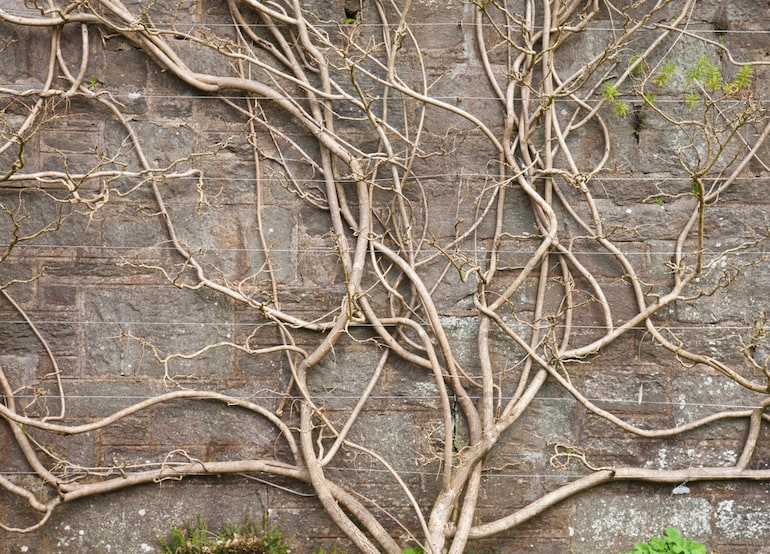How to grow wisteria

Wisteria makes a fabulous statement on a wall, fence or pergola
Image: Shutterstock
Wisteria is the quintessential climber for the English cottage garden and an absolute joy in May and June when the beautiful, scented pendants of flowers create a breathtaking display.
But often gardeners find these climbing plants a little daunting – the idea of all that pruning and training feeling far too complicated. It’s a shame because growing wisteria is much easier than you might think. In fact, with the correct care these long-lived climbers will reward you with many years of pleasure. Read our useful guide on how to grow & train Wisteria below.
Choosing a wisteria

Wisteria Sinensis or Chinese Wisteria has shorter blooms than its Japanese cousin
Image: Shutterstock
There are lots of cultivars available but most are produced from two species – wisteria sinensis (Chinese wisteria) and wisteria floribunda (Japanese wisteria). Here are the main differences between them:
| Species | Stems | Flowers | Approximate flower length |
|---|---|---|---|
| W. sinensis | Twine anti-clockwise | Appear before the foliage develops | 23-30cm (9-12") |
| W. floribunda | Twine clockwise | Appear at same time as foliage develops | 30-45cm (12-18") |
Where to plant wisteria

Wisteria is often grown around entrances
Image: SpiffyStephie/Shutterstock
Location is in important factor to consider when growing wisterias. They’re long-lived and form woody stems which require significant support. This makes them very difficult to move if you change your mind in a few years time. They also require regular pruning to keep them under control and to encourage flowering, so it’s well worth taking your time to choose the best possible location for your plant.
Grow wisterias in a sunny or semi-shaded site in any moist, well drained soil. Wisteria flower buds can be damaged by hard spring frosts so choose a sheltered position if possible.
How to plant wisteria

Wisteria does well when trained
Image: Debu55y/Shutterstock
The ideal way to grow wisterias against a wall is to train them as an espalier, with horizontal support wires (3mm galvanised steel) set 45cm (18") apart. Alternatively, you can train them onto a sturdy pergola, or even onto a tree. Supports are best put in place before planting as it will be much harder to install them once the wisteria is in the ground.
Plant your wisteria in autumn or spring. Prior to planting, add plenty of well-rotted manure or garden compost to the soil to improve its fertility and drainage. It’s vital to take the time to create ideal soil conditions for your wisteria from the very beginning, because you’ll be living with the plant for very long time.
When planting out your wisteria, use the depth that it was planted in the pot as your guide. If you’re planting a bare-root wisteria then look for a soil mark towards the base of the stem which indicates the depth to which it was planted in the ground at the nursery. This is usually found a little below the graft point – a bulge in the stem where the main plant is grafted to the rootstock.
How to look after wisteria

A well cared for wisteria will reward you with a fine display of scented blooms
Image: Alena.Kravchenko/Shutterstock
During their first year, wisterias benefit from regular watering to help the roots establish. Once established, wisteria should only need supplementary water during dry periods. You may wish to apply a high potash feed during the spring to encourage flower production, but don’t overdo it because overfeeding can result in more foliage and fewer flowers.
Why isn't my wisteria flowering

Wisteria flower buds can be damaged by hard spring frosts so choose a sheltered position if possible
Image: Shutterstock
The answer to this, one of the most frequently-asked gardening questions we receive, usually lies in one of the following explanations.
- Pruning. Wisterias need pruning twice a year in July/August and again in February.
- Seed-raised plants. Wisterias grown from seed can take up to 20 years to flower, however these are quite unusual. Nonetheless, it’s worth checking the base of your plant’s stem for signs of a graft in order to eliminate this as a possible cause of flower failure.
- Watering. Wisterias often thrive on neglect, but they do appreciate some extra water between July and September. This is when the buds are formed for next year’s flowers. If they run short of water during these months this can reduce your display the following summer.
- Frost. Spring frosts can sometimes cause the developing buds to drop before they get a chance to open. The best way to avoid this is to plant your wisteria in a sheltered spot.
How to prune wisteria

Wisteria is often used as a spectacular centrepiece by landscape designers
Image: Puffins Pictures/Shutterstock
Just the thought of wisteria pruning sends some gardeners into a panic, but it’s really not difficult once you understand a few basic principles.
Unlike many plants, wisteria needs to be pruned twice a year – once in late winter (February) to prepare the flowering spurs for the coming season, and again in mid-summer (July to August). Summer pruning controls those long, whippy shoots that are heading off into the distance, and encourages them to become flowering spurs instead.
During the first two years, the aim of pruning is to train wisteria to create a framework of permanent stems. This involves selecting and tying-in specific main shoots to the supporting wires and cutting back any unwanted growth. After two or three years, the plants will build up a strong branching habit which forms the ‘skeleton’ of your wisteria.
Now you have the basics of growing wisteria, we really hope you’ll feel confident to give it a go. But do remember, while correct training and pruning of wisteria definitely encourages better flowering, these plants are surprisingly forgiving. If you're looking for more information about growing other types of climbing plants, head over to our hub page.
Quick guide:
How do you grow wisteria?
Grow wisteria in a sunny or semi-shaded site in any moist, well drained soil. Wisteria flower buds can be damaged by hard spring frosts so choose a sheltered position. In time wisteria forms thick, woody stems that require significant support.
Why isn't my wisteria flowering?
Wisteria needs to be pruned correctly in order to flower. While wisteria often thrives on neglect, it also appreciates extra water between July and September when the buds are formed for next year's flowers. Over feeding can produce more foliage and fewer flowers.
When do you prune wisteria?
Unlike many plants, wisteria needs to be pruned twice a year – once in late winter (February) to prepare the flowering spurs for the coming season, and again in mid-summer (July to August). During the first two years, the aim of pruning is to train wisteria to create a framework of permanent stems.
Written by: Sue Sanderson
 Plants and gardens have always been a big part of my life. I can remember helping my Dad to prick out seedlings, even before I could see over the top of the potting bench. As an adult, I trained at Writtle College where I received my degree, BSc. (Hons) Horticulture. After working in a specialist plantsman's nursery, and later, as a consulting arboriculturalist, I joined Thompson & Morgan in 2008. Initially looking after the grounds and coordinating the plant trials, I now support the web team offering horticultural advice online.
Plants and gardens have always been a big part of my life. I can remember helping my Dad to prick out seedlings, even before I could see over the top of the potting bench. As an adult, I trained at Writtle College where I received my degree, BSc. (Hons) Horticulture. After working in a specialist plantsman's nursery, and later, as a consulting arboriculturalist, I joined Thompson & Morgan in 2008. Initially looking after the grounds and coordinating the plant trials, I now support the web team offering horticultural advice online.
Sign Up For Exclusive Special Offers




© 2025 Thompson & Morgan. All rights reserved. A division of Branded Garden Products Limited.



